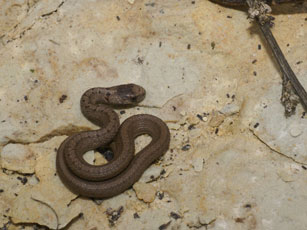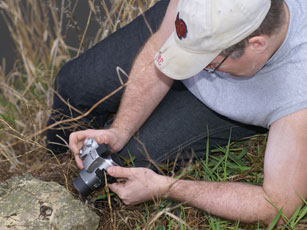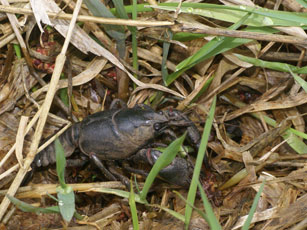
3-24-12
Trip Details
Weather: Overcast with sun breaking through later in the afternoon. High of 67 degrees. Low to moderate wind.
Time: 10:30 a.m.
Herpers: Don Becker, Jim Scharosch & Matt Ricklefs
Account by: Matt Ricklefs
Photos by: Jim Scharosch & Matt Ricklefs
Thought of the Day: Dark squiggles in fields of gold
As a disclaimer, this post is about the Eastern Massasauga (Sistrurus c. catenatus). Throughout its range in the midwest each population is critical and as such we are respecting this by providing no location information or specifics for the trip. Be assured the necessary people were contacted prior to us being in this known location and all pictures of these snakes were taken “in situ”, meaning we took pictures just as we found them. Thank you for understanding and enjoy this entry!
Prior to getting to our location for the Eastern Massasauga’s we did stop and found a couple of other indigenous herps. The first find was a tiny Brown Snake (Storeria dekayi). It was so small we took a pic along side a wooly bear for comparison. No wooly bears were harmed in the composition of this photo.
Photos by Jim Scharosch
This came in the form of a couple of 8 inch Plains Garter Snakes (Thamnophis radix) and a 5 inch Redbelly Snake (Storeria occipitomaculata).
Photo by Jim Scharosch
Photos by Matt Ricklefs
They were not much in the mood for posing, so we got some quick shots and moved on. Not bad starts to the day, especially since they were all caught under one rock – a triple!
What follows are the series of “in situ” pictures of the Eastern Massasauga (Sistrurus c. catenatus). All were around the same size at approximately 23-36 inches. As you can guess by the thought of the day, all were out basking and we basically just looked for the dark squiggles in the gold grasses. Don was the first to spot one and one of the coolest finds was Jim’s double at the end of the trip. Matt, however, got skunked besides his “triple” on the smalls at the beginning of the day.
Photos by Jim Scharosch
Photos by Matt Ricklefs
One of the reasons they are still doing okay at this location is an abundance of crayfish. The massassauga relies on crayfish burrows for shelter.
Photo by Jim Scharosch
These are really cool snakes and we appreciate allowing us to be very cryptic as to any information as all efforts to protect, study and maintain all populations is well worth the efforts of all people involved.
Happy ‘Sauga-ing!
























